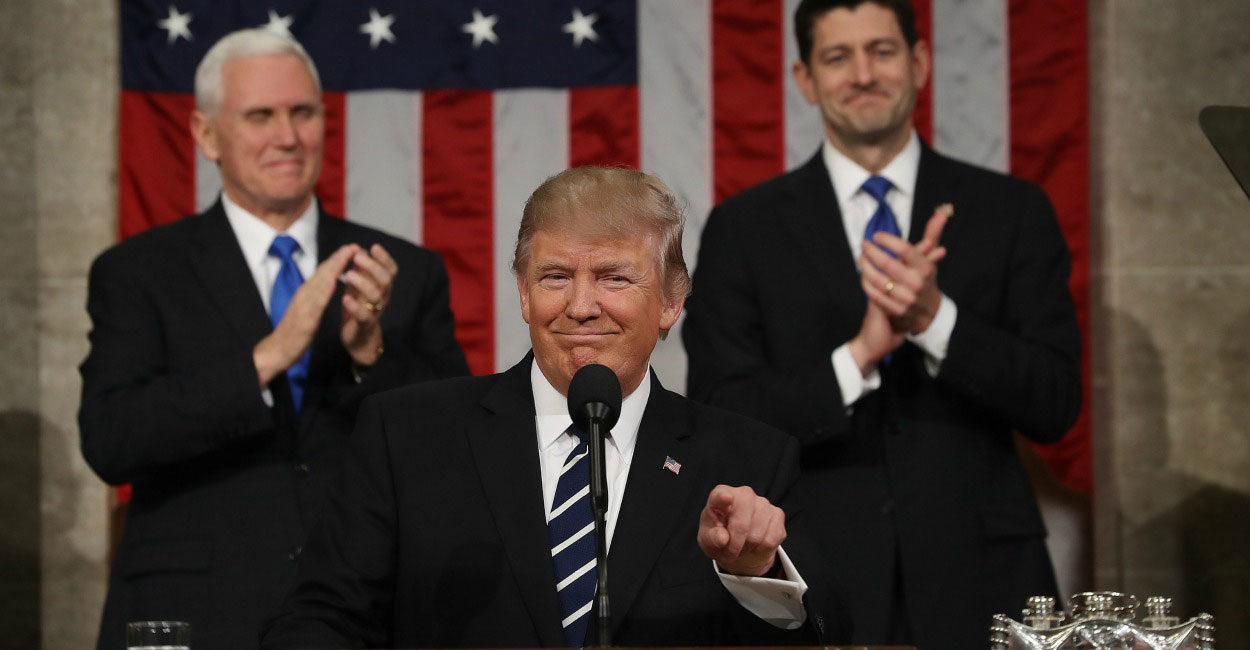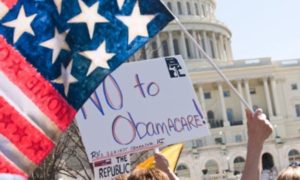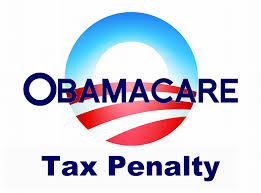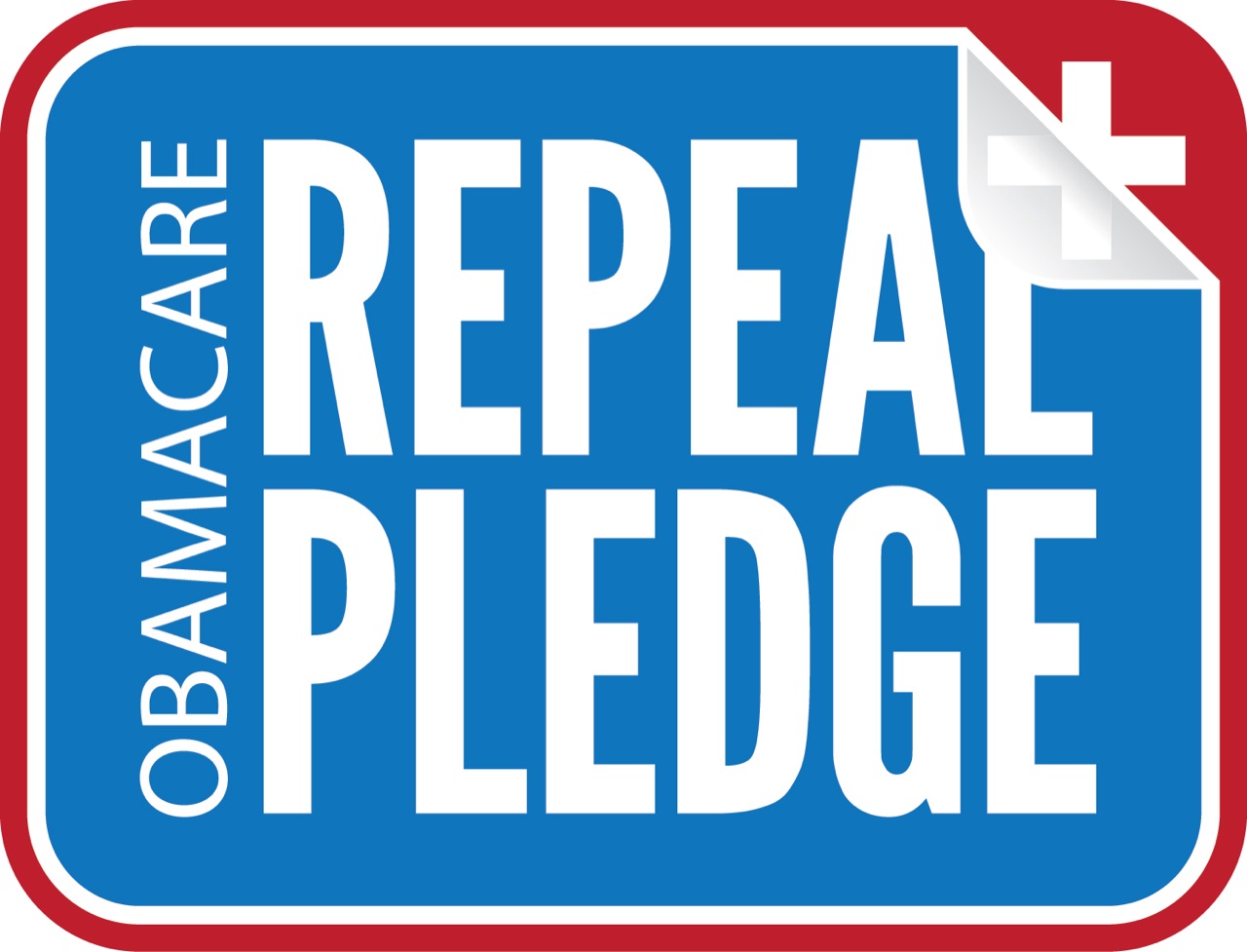In January, President Trump said he wanted to empower local law enforcement to act as immigration officers and help with the “investigation, apprehension, or detention” of immigrants in the country illegally. Traditionally, local police departments are not involved in immigration enforcement and those duties are carried out by federal authorities.
Police chiefs from cities across the U.S. are resisting the move by the administration to enlist local police officers to help deport undocumented immigrants. In a joint letter sent to Congress, 61 sheriffs and police chiefs wrote, “We can best serve our communities by leaving the enforcement of immigration laws to the federal government. Threatening the removal of valuable grant funding from jurisdictions that choose not to spend limited resources enforcing federal immigration law is extremely problematic.” The White House plan would also withhold federal funds from sanctuary cities that refuse to cooperate with federal immigration authorities.
Some of the cities that have vowed not to participate in the involvement of immigration laws include Los Angeles, Newark, New York, Philadelphia, Chicago, Seattle, Providence and Denver. Many expressed concerns that immigrants already wary of reporting crimes or being interviewed as witnesses will retreat further into the shadows.
Trump’s plan is not a new idea but is not regularly practiced throughout the country. A 1996 federal law opened up the possibility for local agencies to participate in immigration enforcement on the streets and do citizenship checks of people in local jails. Immigration and Customs Enforcement trained and certified roughly 1,600 officers to carry out these checks from 2006 to 2015.
The Obama administration phased out all the arrest power agreements in 2013, but still let agencies check whether people jailed in their jurisdiction were citizens. If an inmate is found to be in the country illegally, the department typically notifies federal authorities or hands them over to immigration officers. Today, more than 30 local agencies participate in the jail program.
Experts said Trump’s outreach to local law enforcement will create an even bigger split between sanctuary cities that keep police out of immigration enforcement and those eager to help the new president bolster deportations.
During the election, Trump found support among some law enforcement officers who viewed him as more pro-police than his Democratic opponent. But even officers who privately said they had voted for him- are not eager to help with his immigration agenda. Many officers feel that they have enough on their plate. They are too busy answering 911 calls, arresting robbers, stopping erratic drivers and solving homicides to add federal immigration enforcement to their to-do lists.
Read more


Congressional leaders in the U.S. House of Representatives on Monday released their long-awaited plan for the dismantling of the ‘Affordable’ Care Act (ACA), commonly referred to as Obamacare.
The 123-page bill, called the American Health Care Act, would replace the ACA’s income-based premium tax credits with fixed, age-based tax credits that generally would be smaller. It would end enhanced federal funding for states to expand Medicaid to low-income adults. And it would convert Medicaid from an open-ended entitlement to a program of capped, per-capita payments to the states.
The plan would also repeal Obamacare’s statute assessing the unpopular fines on people who don’t have health insurance, and do not qualify for an exemption. It also allows insurers to increase premiums on those who have gone without insurance for a period of time.

WHAT THE BILL DOES NOT CHANGE:
The bill keeps in place two of the most popular Obamacare provisions: those with pre-existing conditions cannot be denied coverage, and young people can stay on their parent’s health insurance plans until they reach the age of 26.
WHAT WE DO NOT KNOW YET ABOUT THE LEGISLATION:
The cost and number of people who might choose to go without insurance is still unclear. The bill has not yet been scored by the Congressional Budget Office, a nonpartisan congressional research office that provides guidance on economics and the budget for Congress.
The CBO’s guidance will provide information about how many Americans could potentially lose their coverage or opt-out of insuring themselves and the full cost of the bill.
This piece of legislation maintains exemptions that employer-plan premiums currently enjoy, but congressional leaders predict that they will still be able to save money from tax refunds from the repealing of ACA spending and taxes.
 President Trump has railed against the ‘Affordable’ Care Act, calling it a “horrible disaster” and a “lie” and made its replacement a top priority. In fact, some insurance carriers have publicly proclaimed that President Barack Obama’s signature heath reform legislation, had now fallen into a “death spiral”, with one-third of the country being served by only one insurer, and rate hikes that in some states were over 112% higher than their 2016 premiums.
President Trump has railed against the ‘Affordable’ Care Act, calling it a “horrible disaster” and a “lie” and made its replacement a top priority. In fact, some insurance carriers have publicly proclaimed that President Barack Obama’s signature heath reform legislation, had now fallen into a “death spiral”, with one-third of the country being served by only one insurer, and rate hikes that in some states were over 112% higher than their 2016 premiums.
Congressional leaders acknowledge that their plan may cover fewer people, saying that unlike ObamaCare, they are not forcing people to buy coverage through a mandate – it will be up to the individual consumer to decide if they wish to purchase the insurance, and which plan they choose instead of the government mandating plans. They say their system is less intrusive and provides people a tax credit without mandates or a range of tax increases.
To pass the bill through the reconciliation process and avoid a Senate Democratic filibuster, Republicans will have to convince the Senate parliamentarian that ALL the provisions of the bill are germane to the budget. And the bill can’t be deemed to increase the federal deficit 10 years or more from now. Some of the bill’s insurance market changes may have a tough time surviving those procedural tests. By using the budget reconciliation process, the U.S. Senate can pass the bill with a simple 51 vote majority – not the normal 60 votes which would require Democratic support.

Congress had completed the initial phase of a three-step process to kill Obamacare in January, by passing in a vote of 51 to 48, and followed up by a 227-198 vote in the House, a budget resolution to repeal and replace Obamacare.
The new budget reconciliation legislation (Step 2) introduced this week is now in committee, and will then go up for a vote in both houses of Congress, possibly later this month in March. If the Senate gets its 51 votes and the House gets its simple majority, the reconciliation will pass. Only then will the parts of Obamacare detailed within this week’s bill be repealed. The rest of it will have to be disassembled, possibly piecemeal, with bipartisan support in what would be Step 3 later this year.

* * * * * * * * * * * * * *
At Health Insurance 4 Everyone, we not only want to improve our customer service but also interact with our customers on a social media level that was not available before. Interested in connecting with us? Look us up on….
Twitter: Healthinsurane4 
Click-On for LinkedIn: LinkedIn
Like us on facebook: HealthInsurance4Everyone
Follow Mark Shuster, Founder/Owner at Health & Life Solutions, LLC for daily health tips! HealthInsurance4Everyone or Health & Life Solutions, LLC
Mark Shuster FaceBook Link
Follow our word press blogs and read about everything from health insurance and reform news to healthy living and current events! 
Company Blogs
Find out more about LegalShield, our corporate partner which gives you the power to talk to an attorney about any legal issue, and offering high-quality Identity Theft protection plans. 
LegalShield
Read more
The Trump administration announced that it will enforce federal laws barring the use of marijuana, reversing an Obama administration policy that gave wide latitude to states to determine their own pot laws. Eight states – Washington, Oregon, California, Nevada, Alaska, Colorado, Massachusetts, and Maine – and Washington, D.C. have legalized both medicinal and recreational marijuana. The Obama administration had opted not to enforce federal prohibitions in states that had passed legislation legalizing the drug. It’s classified as a Schedule 1 drug — putting it in the same category as heroin — and the government can restrict cross-state shipment and financing as a result.
White House Press Secretary Sean Spicer said the Trump administration would prioritize enforcement in states that have passed laws allowing for the recreational—rather than medical—use of the drug. Just a day after the announcement, publicly traded shares of marijuana-related companies were tumbling and executives at recreational marijuana businesses were expressing their disappointment in the announcement.
The announcement was not a surprise to legalization advocates after Trump’s nomination of Alabama Sen. Jeff Sessions as attorney general. Many advocates feel that Mr. Sessions has been “the single biggest opponent to legalization in the US Senate.”
In August 2013, a four-page directive issued by then-Deputy Attorney General James M. Cole essentially instructs that a hands-off approach be taken by the federal government in states that have voted on laws to legalize marijuana, regardless of the fact that marijuana is illegal at the federal level. The directive has been dubbed the “Cole Memo”.
President Trump has issued differing stances on marijuana legalization. In the 1990s, Trump told the Miami Herald that the US needed to “legalize drugs to win” the war on drugs. And in an interview with Fox News’s Bill O’Reilly a year ago, Trump said he was in favor of medical marijuana “a hundred percent” while also calling Colorado’s recreational marijuana industry “a real problem.”
The industry is still new and is estimated to be worth over $6 billion so the reversal will cost some states millions in revenue and a loss of jobs. Recreational marijuana retailers in Oregon sell about $7 million worth of cannabis every week, or about $364 million a year.
In 2016, the marijuana industry in Colorado created more than 18,000 new full-time jobs and over $1 billion in retail sales. The industry also generated over $1 billion in additional economic activity such as growers renting warehouse space and the purchases of sophisticating lighting and irrigation equipment. Marijuana retailers also boost the economy when they rely on other companies, like contractors, lawyers and bookkeeping services, to conduct their own businesses. If the Trump Administration’s promise of a crackdown does take effect- all of this new found revenue will be lost.
Read more
Many are outraged after a viral video showed an off-duty LAPD officer firing a gun near a group of kids after the officer grabbed a 13-year-old boy by his hoodie and restraining him. The incident took place near the officer’s home in Anaheim, California.
The cellphone video shows a man in plainclothes holding a boy against his will. The boy repeatedly says, “Let me go” but the man refuses. The man, who never identifies himself as an officer is surrounded by other children as he pulls the boy down the street over lawns. Eventually, the other kids come to the aid of the boy, pushing the officer over a row of hedges. The man, who still has hold of the boy is then seen drawing a pistol from his waistband before a gunshot rings out. No one was injured in the incident.
According to one of the youths, the group was walking home from school when the incident took place. The 13 year old says it quickly escalated and turned physical when the man tackled him and choked him. While the video does not show what happened prior, it starts with the boy being restrained and asking to be let go. He then says “why are you grabbing me, I just said not to talk to a girl like that! You called her a dumb c**t.” The man replies that she shouldn’t have been on his lawn.
Anaheim police say the officer had an ongoing dispute against children who were walking on his lawn. Both the 13-year-old boy and his 15-year-old brother were arrested. The off-duty officer, who has not been identified, was questioned by Anaheim police and released.
Overnight, around 300 protesters gathered near the officer’s home, before marching through Anaheim’s streets and blocking intersections. Some protesters shouted “hands up, don’t shoot” and “no justice, no peace.” Some demonstrators threw rocks and kicked police cars, while others broke windows or residences and cars, according to the LA Times.
There was also a small group of protestors who lingered around the officer’s home chanting “Don’t shoot the children.” The officer’s home and vehicle were vandalized before riot police arrived to protect the officer’s home. Twenty-four people were arrested on misdemeanor charges of failure to disperse.
The LAPD says the officer is on paid administrative leave while the department evaluates if his “use of deadly force complied with LAPD’s policies and procedures.” Anaheim police say they are reviewing other videos of the altercation to get a clearer picture of what happened.
Anaheim mayor Tom Tait and Police Chief Raul Quezada both said they were thankful no one was wounded when the officer fired a handgun into the ground. They also both said they are disturbed by video that shows an off-duty Los Angeles police officer firing his gun during a confrontation with a teenager.
Police Chief Quezada told reporters “As a father and as a police chief, I too am disturbed by what I saw on the videos that were posted on the Internet,” He said he hopes a criminal investigation into the matter, which involved several teens and an off-duty Los Angeles police officer who lives in Anaheim, will be completed within two weeks. No one has been formally charged in the incident.
Read more
In northern Afghanistan, six Red Cross workers were killed and two others were missing on Wednesday after an attack. The Taliban quickly denied any involvement in the attack. The governor of Jowzjan Province, Lutfullah Azizi, blamed affiliates of the Islamic State, also known as ISIS, for the attack.
Mr. Azizi said that the Red Cross had begun a mission to distribute livestock material in the Qush Tepah area of Jowzjan Province, where the attack happened, but that its work was suspended by recent avalanches. When workers went to resume giving out aid, they were targeted.
“They were a team of eight people in three vehicles, including three drivers and five staff,” Mr. Azizi said. “Islamic State attacked the convoy, killed the three drivers and three staff members on the spot and took two staff members with them.”
The plan was for the Red Cross staff to help distribute the 1,000 tons of feed, which is critical for farmers because there is nowhere for animals to graze in the winter months. Before the vehicles got to the distribution point, they were ambushed by armed men. The panic button sent an alert to Red Cross offices in Kabul, but efforts to reach the staffers by satellite phone and other means failed. “We couldn’t get hold of them,” says Thomas Glass, head of communications for the International Committee of the Red Cross in Afghanistan. The Red Cross is “desperately” searching for the two missing field staff members.
Glass stated that the Red Cross has 30 years of continuous presence in Afghanistan and they are well-known and respected for their work within the communities they serve. The vehicles are clearly marked so the ambush has all the signs of a deliberate attack. Red Cross workers being attacked in Afghanistan is nothing new but the loss of 6 lives at one time seems like another level of violence.
In Afghanistan, the Red Cross helps with many efforts for the communities such as supporting health care, anti-poverty work and sanitation efforts. The Red Cross issued a statement that activities are suspended until Tuesday, possibly longer. Certain activities will continue, such as the treatment of patients at medical facilities will continue but any movement in the field, including the transfer of war-wounded to hospitals, has been put on hold.
Qush Tepah is about 37 miles from the provincial capital and is rife with militant groups, including five Islamic State factions with an estimated 200 fighters. A spokesman for the northern police zone said there were about 600 foreign fighters in five Northern provinces.
In recent weeks, officials in northern Afghanistan had expressed concern about an increase in foreign fighters there, many of them suspected of affiliation with the Islamic State. Amnesty International condemned the attack and noted that violence has intensified recently in Afghanistan. The work of humanitarian workers and journalists has become increasingly dangerous as there has been an increase of deliberate attacks on aid workers and journalists.
Read more
President Trump has imposed a controversial 90-day ban on travelers from Iran, Iraq, Libya, Somalia, Sudan, Syria and Yemen. On January 27th, Trump signed the order banning travel from the seven Muslim-majority countries for 90 days and suspending all refugee admission for 120 days. Homeland Security Secretary John Kelly and Department of Homeland Security (DHS) leadership saw the final details shortly before the order was finalized.
The result was widespread confusion across the country on Saturday as airports struggled to adjust to the new directives. Stories of families separated or detained for hours starting circulating news outlets.The policy team at the White House developed the executive order on refugees and visas and avoided the traditional inter-agency process that allowed the Justice Department and homeland security agencies to provide operational guidance.
DHS arrived at the legal interpretation that the executive order restrictions did not apply to people with lawful permanent residence, referred to as green card holders. The White House overruled that guidance overnight and decided that on a case by case basis, DHS could allow green card holders to enter the US. The Department of Homeland Security decided that green card holders would be allowed to board international flights but would be considered on a case-by-case basis after passing a secondary screening.
Acting Attorney General Sally Yates announced the Justice Department would not defend Trump’s executive order temporarily banning all refugees, as well as all citizens, from the seven Muslim-majority nations. Just hours after her announcement, President Trump fired her. Yates had served in the Justice Department for 27 years and Trump had asked her to serve as acting attorney general until the Senate confirmed Sen. Jeff Sessions.
Yates is not the only one to publicly disagree with the executive order. More than 200 State Department officials and diplomats have signed on to drafts of a dissent memo that condemns Trump’s executive order. Executives at a growing number of corporations have spoken out against Trump’s immigration ban, including Google, Apple, Microsoft, Amazon, Facebook, Netflix, Tesla, Airbnb, Ford and Goldman Sachs. World-wide protests has erupted across the globe as well.
Then, Federal Judge James Robart, who presides in Seattle, halted the enforcement of Trump’s order Friday night, effective nationwide. Ruling in a lawsuit brought by the attorneys general of Washington state and Minnesota who sought to stop the order, he said the states “have met their burden of demonstrating that they face immediate and irreparable injury as a result of the signing and implementation of the Executive Order. ” He said the order adversely affects residents in areas of education, employment, education and freedom to travel.
The Department of Homeland Security announced it has suspended all actions to implement the immigration order and will resume standard inspections of travelers as it did prior to the signing of the travel ban. They said the Justice Department — which is expected to file an emergency motion to stop the order — needed to challenge the ruling “at the earliest possible time.”
Read more


In a press conference earlier in January, to announce the start of the 2017 tax filing season, which began on Jan. 23rd, the IRS said it expects more than 153 million tax returns this year.
More than 70% of taxpayers will receive a refund in 2017, with 90% or more of refunds issued in fewer than 21 days after returns are submitted, the IRS estimated. In 2016, 111 million individual tax refunds were issued.
Most filers who received government subsidies to buy Obamacare state exchange plans had to pay money back to the IRS last year, according to an H&R Block analysis released in 2016 that looks at the health law’s two full tax seasons. If a taxpayer projected a higher annual household income than they actually claimed in their filing, they may owe tax credits back that they received by purchasing an Obamacare policy or their state’s exchange plan. One other cause for having to repay tax credits is due to claiming eligibility, but not being eligible due to having access to affordable employer coverage.
The tax-prep giant studied its own massive customer base and concluded that two-thirds of its filers who got subsidies from Obamacare were overpaid during the course of the year, and owed money back to the IRS on the April 15th deadline. 
The ‘Affordable’ Care Act, better known as Obamacare, mandates Americans — unless they’re qualified for an exemption — to carry health insurance coverage or pay a penalty when filing their tax returns. The IRS says most taxpayers simply need to check a box to verify that they have insurance. For others with more complex answers, the agency offers tips on IRS.gov/aca.
IRS Commissioner John Koskinen said the number of people receiving Obamacare subsidies during the last tax season (2015 tax filing), was up from 3 million in 2014. For that year, customers got more than $10 billion in tax credits, with an average subsidy of $3,430 annually, according to the IRS. Obamacare subsidies are available to wage earners with low and moderate incomes. People who earn less money get more in assistance than higher earners.
Koskinen wrote that about 6.5 million taxpayers last tax season reported owing a total of $3 billion in such tax penalties for failing to have coverage in 2015. In contrast, about 8 million people owed an Obamacare fine for lack of coverage in 2014. Fines related to lack of coverage in 2014 totaled $1.6 billion.
CNBC reported that some 12.7 million people claimed one or more exemptions from the ACA-coverage mandate when they filed their taxes last year. “The exemptions are wide ranging and can include having very low income, being incarcerated or having a close family member die recently,” according to CNBC.
The primary reason for the decline in Obamacare fines last year appears to be that millions of Americans experienced a significant drop in income, which ironically is a direct result of the economic damage inflicted on businesses by the financial strictures of the Obama ‘Affordable’ Care Act (ACA).
CNBC also reported that the new Republican-led Congress last month began taking steps toward repealing key parts of the ACA, which include the funding of premium subsidies and the individual mandate. For the middle class’s economic sake, let’s hope the effort is successful.

The National Taxpayer Advocate has released their 2016 Annual Report to Congress. The report contains data regarding Obamacare premium tax credits (PTC) and individual shared responsibility payment (ISRP) filings – The Obamacare tax penalties for not having health coverage.
The report identifies a number of issues that the IRS has faced or is facing involving the Obamacare ACA and makes a number of recommendations. These include:
- The IRS seems to have largely addressed early problems of Obamacare tax overpayments through outreach conducted to tax practitioners and software providers.
- Reconciliation of PTCs (the Obamacare low-income subsidies) with advance PTCs (APTCs) continues to cause problems, and has risen to the fourth highest category of Taxpayer Advocacy Service cases, accounting for nearly 11,000 cases in 2016. The primary problem seems to be the IRS holding up processing of returns when taxpayers fail to file a form 8962 and reconcile their advance PTC with their PTC.
- Processing of tax filings is delayed when Obamacare APTC recipients incorrectly file form 1040-E, which does not allow for APTC reconciliation.
- The IRS is taking action to address “silent returns,” which do not either check the box indicating full-year coverage, claim an exemption, or paying the ISRP tax penalty. The IRS will send a letter 12C requesting more information in these cases and assess the ISRP if no response is forthcoming.
- The Taxpayer Advocate recommends that the IRS should ease the burden on individuals claiming the religious exemption by allowing individuals exempt from the Social Security and Medicare taxes to simply indicate this on their form 8965 rather than requiring them to apply separately for an Obamacare ISRP religious exemption.
- The Taxpayer Advocate recognizes that taxpayers who receive large Social Security Disability Payments may have to repay Obamacare APTC subsidies they received. There is no apparent administrative fix for this problem.
- The IRS needs to provide specialized training to its newly established Obamacare ACA Business Exam unit, which handles employer ACA returns.
- The IRS may not be adequately prepared to handle Obamacare ACA employer filings. It had expected 77 million 1095-Cs for 2016 and received 104 million or 35% more than expected. Of these Obamacare employer filings, 5.4 percent were then rejected.

The IRS, in a statement regarding taxpayer compliance issues has said: “The IRS will follow its normal compliance approach to filed tax returns. During its normal processes, the IRS routinely follows up on the accuracy and completeness of tax returns and may ask taxpayers to substantiate the information on their tax returns. These inquiries sometime occur before processing refund requests and other times after the processing of refund requests.”
“The vast majority of taxpayers voluntarily comply with their tax responsibilities—our income tax system is built on voluntary compliance,” the IRS said.
* * * * * * * * * * * * * *
At Health Insurance 4 Everyone, we not only want to improve our customer service but also interact with our customers on a social media level that was not available before. Interested in connecting with us? Look us up on…. 
Twitter: Healthinsurane4
Click-On for LinkedIn: LinkedIn
Like us on facebook: HealthInsurance4Everyone
Follow Mark Shuster, Founder/Owner at Health & Life Solutions, LLC for daily health tips! HealthInsurance4Everyone or Health & Life Solutions, LLC
Mark Shuster FaceBook Link
Follow our word press blog and read about everything from health insurance and reform news to healthy living and current events!
Company Blogs 
Find out more about LegalShield, our corporate partner which gives you the power to talk to an attorney about any legal issue, and offering high-quality Identity Theft plans.

Read more


JAMA Forum: How Will President Trump’s Policies Affect Domestic and Global Health and Development?
By Lawrence Gostin, JD on January 11, 2011

Donald Trump’s election to the US presidency marks a time of global transition, with singular importance to health. The world is witnessing the rise of populist movements characterized by concerns about trade, immigration, globalization, and international organizations. These seismic events could have profound effects on health and development in the United States and globally.
There is still a great deal we don’t know about the policies of a Trump administration, and how those policies will unfold in a constitutional system of checks and balances. Trump has not laid out specific details on major domestic policies, such as reforms related to the Affordable Care Act (ACA) or reproductive rights. Even less well understood are his views on global health issues, such as health assistance, the Paris Climate Change Agreement, and the World Health Organization (WHO).
Based on Trump’s earlier statements, what can we expect for 2017 and beyond?
The Affordable Care Act
A recent JAMA Viewpoint identified 4 major ACA reforms discussed by the House leadership and President-elect Trump: health savings accounts, selling health insurance across state lines, Medicaid block grants, and malpractice reform. Congress has already taken the first steps to repeal the ACA, with implementation possibly delayed before a replacement is enacted. His nominee for Secretary of the Department of Health and Human Services (HHS), Rep Tom Price, MD, (R, Georgia), earlier introduced legislation to dismantle the ACA. There is little empirical evidence that current Republican proposals would retain health coverage gains or significantly lower health care costs.
President-elect Trump has said he plans to keep 2 popular ACA features, retaining coverage of preexisting conditions and of dependent children up to age 26 years. The ACA was able to offer these benefits by widening the pool of insured individuals, particularly younger and healthier enrollees, through individual and employer mandates, which Trump opposes. Republican proposals also would not maintain subsidies in health insurance exchanges or retain the Medicaid expansion. This leaves 2 major unanswered questions: how to widen risk pools to stabilize insurance markets and how to maintain the gains in coverage.
Reproductive Health and Rights
Trump has vacillated on his views about reproductive health, although Vice President–elect Pence and Rep Price favor restricting contraception coverage and abortions and eliminating federal funding for Planned Parenthood. Although Trump might not fight for new federal abortion restrictions, he would likely turn a blind eye to state restrictions. The Supreme Court recently struck down 2 onerous state abortion restrictions, but the majority of states still have restrictive legislation in place.
As part of the law’s commitment to covering preventive services, the ACA guarantees access to reproductive and family planning services, such as contraception. Because family planning and other preventive services are defined in an administrative regulation, the HHS Secretary could change the rule without congressional approval. Eliminating this benefit would cause real financial hardship for many of the 62% of all women of reproductive age who use contraception.
Trump promised to nominate a strong “pro-life” Supreme Court justice, putting the Court in the same closely divided position before Justice Antonin Scalia’s death. If there were additional vacancies during Trump’s presidency, the Court’s pro-life block would probably prevail. Reproductive rights are facing strong headwinds as states pass laws that make it harder for poor women to access safe, legal abortions.
Climate Change
Climate change holds short-term and long-term peril for domestic and global health. Experts say it will exacerbate severe weather events, fuel heat waves, increase pollution, alter the geographical reaches of disease vectors, and produce crop failures, thereby increasing injuries, malnutrition, infectious diseases, asthma, and cardiovascular disease.
Trump (who, along with his nominee for the Environmental Protection Agency, Scott Pruitt) is distrustful of climate science. He pledged to undo the Obama Administration’s 2016 greenhouse gas targets and revoke financial commitments to United Nations (UN) climate change programs—although he said he had an “open mind.” His commitment to fossil fuel development (coal and oil) could reduce incentives for clean alternatives. At the same time, if he rejects the Paris accord, other world leaders might similarly renege on their environmental promises.
International Health
Broad bipartisan support exists for former President George W. Bush’s President’s Emergency Plan for AIDS Relief (PEPFAR), and successive presidents have supported the Global Fund to Fight AIDS, Tuberculosis and Malaria. Trump has not signaled diminished support for these programs, but international health assistance probably will be flat-lined, possibly reduced. This will maintain the US support for antiretroviral treatment in Africa and elsewhere, but would do little to expand coverage.
President Obama’s signature global health achievement is not likely to fair as well. His $1 billion Global Health Security Agenda (GHSA) is strengthening health systems in lower-income countries. President Obama also advocated for US leadership and funding during the Ebola and Zika outbreaks during his term. Trump would be less likely to push Congress to renew GHSA funding or allocate major resources to fight the next global health emergency.
The WHO has introduced major reforms, including a new health emergencies program and joint external evaluation of national health systems. Yet its new program is significantly underfunded. Absent GHSA funding to the Centers for Disease Control and Prevention and WHO, we are unlikely to see significant improvements in epidemic preparedness. That would leave the world highly vulnerable to novel circulating viruses and influenza strains.
Refugee Health
The millions of refugees fleeing conflicts in the Middle East and North Africa often lack basic health needs such as potable water, nutritious food, and housing. Overcrowded conditions fuel infectious disease outbreaks, while vulnerable women face sexual assaults. Turning the tide on these health threats requires humanitarian assistance and a willingness to shoulder a fair share of the burden in welcoming refugees. A new US administration is unlikely to increase (and may reduce) humanitarian assistance, while turning away vulnerable immigrants. Two hallmarks of Trump’s campaign were an antiimmigrant sentiment and an insistence on increased border security, both of which would harm refugees and other vulnerable immigrants.
Health, Development, and the Environment in the Balance
Fresh leadership at the UN and WHO, together with the Sustainable Development Goals, offers great promise. António Guterres, the former UN High Commissioner for Refugees, began serving as the ninth UN Secretary-General on January 1, and in May, the World Health Assembly will elect a new WHO Director-General. Both are charged with the task of working toward the ambitious UN Sustainable Development Goals, including bold health targets such as universal health coverage and fighting noncommunicable diseases.
The United States has historically exercised global health leadership, while sharply increasing health insurance coverage domestically under the Obama administration. As Trump takes office with the promise to “put America first,” what will that mean for our commitments to global health and progress toward universal health coverage? The future of health, development, and the environment hangs in the balance.
***
About the author: Lawrence O. Gostin, JD, is University Professor and Faculty Director, O’Neill Institute for National and Global Health Law, Georgetown University Law Center, and Director of the World Health Organization Collaborating Center on Public Health Law and Human Rights. His most recent book is Global Health Law (Harvard University Press).
* * * * * * * * * * * * * *
At Health Insurance 4 Everyone, we not only want to improve our customer service but also interact with our customers on a social media level that was not available before. Interested in connecting with us? Look us up on….
Twitter: Healthinsurane4 
Click-On for LinkedIn: LinkedIn
Like us on facebook: HealthInsurance4Everyone

Follow Mark Shuster, Founder/Owner at Health & Life Solutions, LLC for daily health tips! HealthInsurance4Everyone or Health & Life Solutions, LLC
Mark Shuster FaceBook Link
Follow our word press blog and read about everything from health insurance and reform news to healthy living and current events!
Company Blogs
Find out more about LegalShield, our corporate partner which gives you the power to talk to an attorney about any legal issue, and offering high-quality Identity Theft plans.

LegalShield
Read more






















